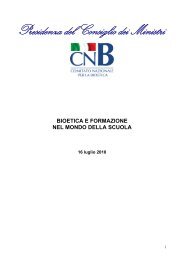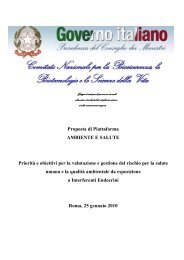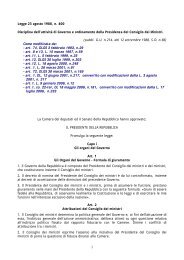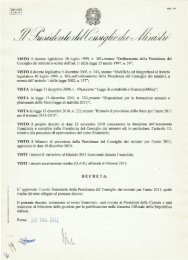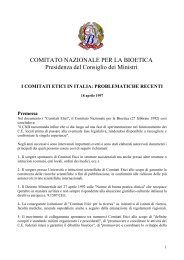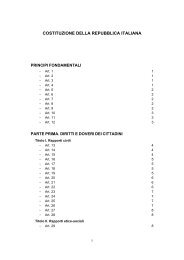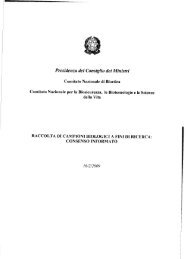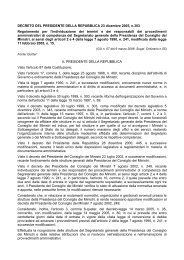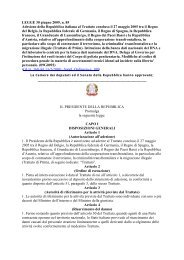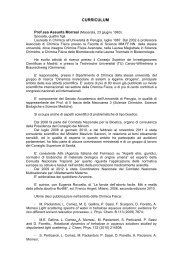President
President
President
You also want an ePaper? Increase the reach of your titles
YUMPU automatically turns print PDFs into web optimized ePapers that Google loves.
3. human cells transplanted in animal embryos or foetuses.<br />
Case 1. is exemplified by animal oocytes (rabbit), denucleated, fused with<br />
a cell from human skin, as indicated by Chen et al. 12 : when the blastocyst state<br />
is reached (5-7 days), the cells behaving like stem cells, differentiating in<br />
different populations, including neuroblasts and myoblasts, are isolated. These<br />
experiments have been discussed by the Scottish Bioethics Committee 13 ,<br />
which has raised doubts about their ethical aspects. Similar experiments have<br />
been reported by Illmensee et al. 14 , who have fused denucleated cow oocytes<br />
with ovary granulose cells or with skin fibroblasts. Some of these fusions have<br />
created blastocysts after six days 13, 15 .<br />
Case 2. according to Mikkelsen 16 has not yet been found in literature.<br />
Case 3. is the one most commonly found. According to Mikkelsen 16,<br />
transplants of embryonic human stem cells in mouse or other animal<br />
blastocysts have not been described. Instead, numerous experiments of stem<br />
cells transplant in animal foetuses, including human stem cells obtained from<br />
tissue (or in any case more differentiated sources). For example, Ogle et al. 17<br />
introduced human hematopoietic stem cells in pig foetuses and observed both<br />
unmodified human cells and human cells fused with pig cells, in a 40:60<br />
proportion. The same phenomenon has also been observed in other chimerical<br />
animals 18 . Moutri et al. 19 transplanted human embryonic stem cells into the<br />
cerebral ventricles of murine foetuses, in order to study their ability to<br />
differentiate in neuronal cells, and observed the formation of synapses between<br />
the two neuronal populations, at different levels of cerebral architecture (cortex,<br />
hippocampus, thalamus and cerebellum). The overall population of human<br />
derivation has been estimated to about 0.1%. Bruestle et al. 20 transplanted<br />
cerebral stem cells of human foetuses, 53 and 74 days old, in the ventricles of<br />
rat foetuses (17-18 days old). Eight weeks after the transplant, human cells<br />
were incorporated in a variety of the guest’s cerebral areas (amongst other, in<br />
the cortex, in the hippocampus and in the olfactory bulb), where they<br />
differentiated in astrocytes, oligodendrocytes and neurons. Zanjani et al. in<br />
1995 21 and in 1996 22 implanted hepatic cells of human foetuses, 12 and 15<br />
12 Y. Chen et al., Embryonic stem cells generated by nuclear transfer of human somatic nuclei<br />
into rabbit oocytes, “Cell Research”, 2003, 13, pp. 251-264.<br />
13 Scottish Council on Human Bioethics, Embryonic, foetal and post-natal animal. Human<br />
mixtures, 2005.<br />
14 K. Illmensee et al., Evaluation of the embryonic preimplementation potential of human adult<br />
somatic cells via an embryo interspecies bioassay using bovine oocytes, “Fertil. Steril.”, 2006,<br />
85, suppl. 1, pp. 1248-1260.<br />
15 P.M. Zavos, Human reproductive cloning: the time is near, “Reproduc., Biomed., Online”,<br />
2003, 6, pp. 397-398.<br />
16 T.R. Mikkelsen, Examples of Scientific Articles about Animal-Human Hybrids and Animal-<br />
Human Chimeras, in “Man or Mouse?”, The Danish Council of Ethics, Report on Ethical<br />
aspects of chimeras research, 2008.<br />
17 B.M. Ogle et al., Spontaneous fusion of cells between species yields transdifferentiation and<br />
retroviral transfer in vivo, “Faseb J.”, 2004, 18, pp. 548-550.<br />
18 B.M. Ogle et al., Biological implications of cell fusion “Nat. Rev. Mol. Cell. Biol.”, 2005, 6, pp.<br />
567-575.<br />
19 A.R. Moutri et al., Development of functional human embryonic stem cell-derived neurons in<br />
mouse brain, “Proc. N. Acad. Sci.”, 2005, USA 102, pp. 18644-18648.<br />
20 O. Bruestle et al., Chimeric brains generated by intraventricular transplantation of fetal<br />
human brain cells into embryonic rats, “Nature Biotechnology”, 16, pp.1040-1044.<br />
21 E.D. Zanjani et al., Retention and multilineage expression of human haematopoietic stem<br />
cells in human-sheep chimeras, “Stem Cells”, 1995, 13, pp. 101-111.<br />
18




